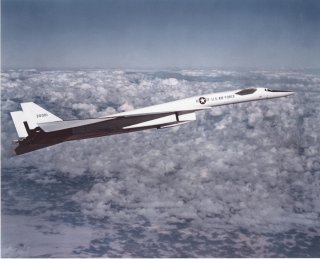This Supersonic Bomber Could Have Terrorized Russia. But It Never Had the Chance.
Why?
Taken on Sept. 21, 1964, the interesting photo in this post features the North American XB-70 Valkyrie experimental aircraft performing its maiden flight which actually saw the aircraft taking off from Plant 42 in Palmdale, California, and landing to Edwards Air Force Base (AFB). The XB-70 was flown by North American test pilot Alvin S. White and Col. Joseph F. Cotton.
The futuristic XB-70A Valkyrie was originally conceived in the 1950s as a high-altitude, nuclear strike bomber that could fly at Mach 3 (three times the speed of sound) – any potential enemy would have been unable to defend against such a bomber.
By the early 1960s, however, new Surface-to-Air Missiles (SAMs) threatened the survivability of high-speed, high-altitude bombers. Less costly, nuclear-armed Intercontinental Ballistic Missiles (ICBMs) were also entering service.
As a result, in 1961, the expensive B-70 bomber program was canceled before any Valkyries had been completed or flown.
Even so, the U.S. Air Force (USAF) bought two XB-70As which were used for flight researchinvolving the Air Force and NASA’s Flight Research Center (FRC), which was a predecessor of today’s NASA Dryden Flight Research Center.
The major objectives of the XB-70 flight research program were to study the airplane’s stability and handling characteristics, to evaluate its response to atmospheric turbulence, and to determine the aerodynamic and propulsion performance. In addition there were secondary objectives to measure the noise and friction associated with airflow over the airplane and to determine the levels and extent of the engine noise during takeoff, landing, and ground operations.
While the number two XB-70 was destroyed in an accidental mid-air collision on June 8, 1966, the first Valkyrie continued to fly and generate valuable test data in the research program until its final flight which took place on on Feb. 4, 1969.
This first appeared in Aviation Geek Club here.

